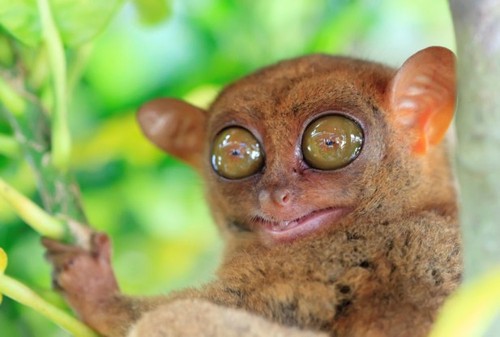 |
| Previous Image | Next Image |
| Description: Bulging Eyes Of The Tarsier Provide Insight Into Evolution Of Human Vision A new study, led by Dartmouth College, suggests that primates developed highly accurate, three-color vision that allowed them to shift to daytime living after eons of wandering in the dark. The findings, published in the journal Proceedings of the Royal Society B: Biological Sciences, challenge the prevailing theory that trichromatic color vision, a hallmark event in primate evolution, evolved only after primates became diurnal. Learning to rise with the sun was an evolutionary shift that gave rise to anthropoid (higher) primates, which led to the human lineage. Dr. Amanda D. Melin, a postdoctoral research associate in the Department of Anthropology at Dartmouth, led the team of scientists who based their findings on a genetic study of tarsiers, the enigmatic elfin primate that branched off early on from monkeys, apes and humans. These tiny animals, which measure between 3.3 and 6.5 inches in height, have a number of unusual traits – from communicating in pure ultrasound to their bulging eyes. Sensory specializations such as these have long fueled debate on the adaptive origins of anthropoid primates. Previous research by this same team discovered the tarsiers’ ultrasound vocalizations last year. The new study sheds light on why the nocturnal animal’s ancestors had enhanced color vision better suited for daytime living conditions, like their anthropoid cousins. The team analyzed the genes that encode photopigments in the eye. This analysis revealed that the last common ancestor of living tarsiers had highly acute, three-color vision much like modern monkeys and apes. Normally, such findings would indicate a daytime lifestyle. The tarsier fossil record, however, shows enlarged eyes that suggest they were active mainly at night. Because of these contradictory lines of evidence, the researchers suggest that early tarsiers were instead adapted to dim light levels, like bright moonlight or twilight. Such conditions are dark enough to favor large eyes, but still bright enough to support trichromatic color vision. Keen-sightedness such as this might have helped higher primates to carve out a fully daytime niche, the authors suggest, allowing them to better see prey, predators and fellow primates. They would also be able to expand their territory in a life no longer limited to the shadows. Picture Stats: Views: 1368 Filesize: 37.52kB Height: 337 Width: 500 Source: https://biology-forums.com/index.php?action=gallery;sa=view;id=11554 Keywords: Bulging Eyes Of The Tarsier Provide Insight Into Evolution Of Human Vision |
